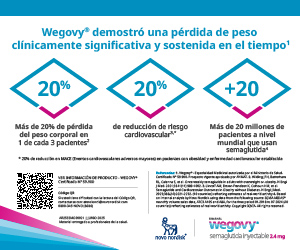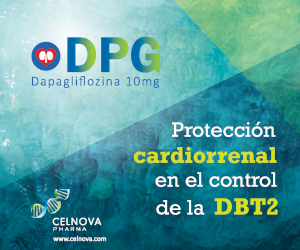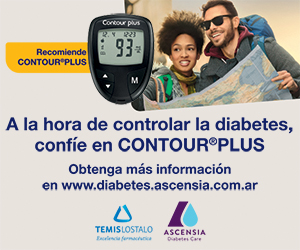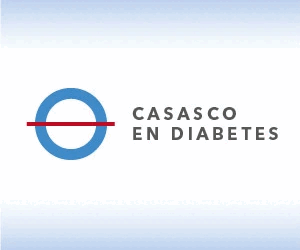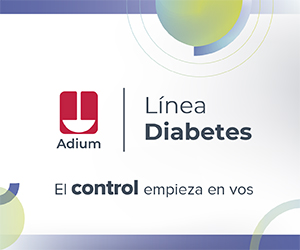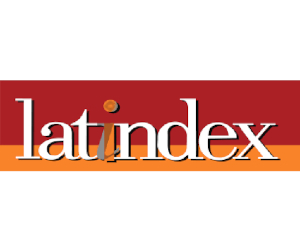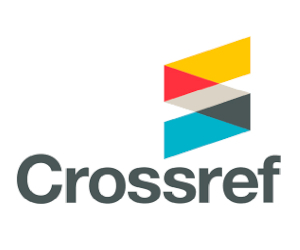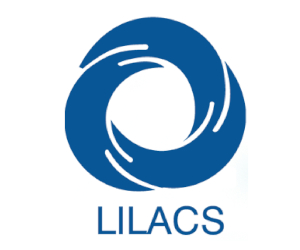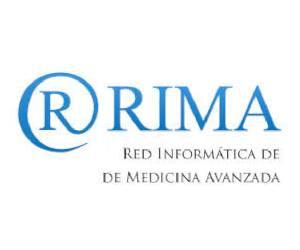XX Conference of the Graduate Committee of the Argentine Diabetes Society. Topic: Obesity and diabetes. Table 2: Nutritional treatment and physical activity
DOI:
https://doi.org/10.47196/diab.v58i3Sup.1268Keywords:
diabetes, obesity, non-caloric sweeteners, intermittent fasting, veganism, sarcopenia, ketogenic, paleolithic, Mediterranean, DASH, nutrigenomics, exercise, HIT, MICT, technologyAbstract
Introduction: the comprehensive management of diabetes mellitus (DM) and obesity requires a personalized, multidisciplinary, evidence-based, and person-centered approach. Nutritional therapy and physical activity are the pillars of treatment for both diabetes mellitus and obesity. The objective of this paper is to review the literature on nutritional therapy and physical activity in relation to DM and obesity.
Materials and methods: a review of the literature published in PubMed was conducted to select relevant studies. Publications with a high level of evidence were prioritized, including clinical guidelines, systematic reviews, meta-analyses, and controlled clinical trials published less than 10 years ago. Observational studies of good methodological quality were also included when they provided specific information not covered by higher-ranking studies.
Results: regarding nutritional strategies, intermittent fasting (IF) shows benefits in weight loss and metabolic profile in people with obesity and T2DM, but is not superior to continuous calorie restriction and carries risks of hypoglycemia in certain patients. Well-planned vegetarian and plant-based diets are associated with a lower risk of chronic diseases, including T2DM, and improve BMI and glycemic control. Ketogenic diets offer short-term benefits in obesity, such as satiety and metabolic improvement, but require strict supervision and do not outperform other diets in the long term. The Paleolithic diet, although with some reported metabolic benefits, has methodological limitations and adherence issues, so it is not recommended as a first-line option. The Mediterranean and DASH diets are patterns with strong scientific support for the prevention and control of cardiovascular disease in people with T2DM, showing improvements in clinical markers. Regarding non-caloric sweeteners (NCS), evidence suggests neutral or modestly beneficial effects in the short and medium term on weight and adiposity, with no negative impact on appetite or glycemia. However, observational associations with increased risk of type 2 DM could be influenced by reverse causality bias. Sarcopenia in aging requires higher protein intake and physical exercise, with heterogeneous evidence on omega-3 and vitamin D supplementation. Managing the coexistence of type 1 DM and obesity requires a comprehensive approach with tailored nutrition and physical activity. Nutrigenomics and nutrigenetics open the door to personalized precision nutrition strategies. Both HIIT and MICT are effective in improving glycemic control and body composition. Finally, digital technologies can improve adherence to physical activity and nutrition interventions.
Conclusions: the Mediterranean and DASH diets have strong scientific support for the prevention and control of cardiovascular disease in people with type 2 diabetes. Ketogenic diets may be helpful in the short term for overweight and obesity under professional supervision, but they are not a long-term or universal solution. The Paleolithic diet shows some benefits for weight management, but the evidence is limited. Well-planned vegetarian and plant-based diets are recommended at all life stages due to their metabolic benefits and their role in preventing T2DM and cardiovascular disease, highlighting their sustainability. Intermittent fasting (IF) appears promising for T2DM and obesity, requiring individualization and medical-nutritional supervision, with continuous glucose monitoring being a useful tool. On the other hand, while non-caloric sweeteners (NCS) are safe within a comprehensive approach, more long-term research is needed on their cardiometabolic impact. In the management of type 1 diabetes mellitus (T1DM) and obesity, specific recommendations are still needed, and further research on safe and effective strategies is warranted. It is also crucial to include comprehensive interventions such as education, exercise, and behavioral support in all cases. For sarcopenia, a combined approach of adequate nutrition, strategic supplementation, and tailored physical activity is essential. Nutrigenetics and nutrigenomics represent a step toward more personalized medicine. Personalized physical activity is essential in the comprehensive management of type 1 diabetes mellitus (T1DM) and type 2 diabetes (T2DM), as well as obesity, for both prevention and treatment, regardless of age. Finally, digital health is emerging as a promising tool with professional guidance and adaptation to patient preferences.
References
I. Instituto Nacional de Estadística y Censos. Encuesta Nacional de Factores de Riesgo. Resultados definitivos. Octubre de 2019. Disponible en: https://www.indec.gob.ar/ftp/cuadros/publicaciones/enfr_2018_resultados_definitivos.pdf.
II. Locke A, Schneiderhan J, Zick SM. Diets for health: goals and guidelines. Am Fam Physician 2018 Jun 1;97(11):721-8.
III. Nosova EV, Conte MS, Grenon SM. Advancing beyond the “heart-healthy diet” for peripheral arterial disease. J Vasc Surg 2015 Jan 1;61(1):265-74.
IV. Fischer NM, Pallazola VA, Xun H, Cainzos-Achirica M, Michos ED. The evolution of the heart-healthy diet for vascular health: A walk through time. Vasc Med 2020 Apr;25(2):184-93. doi: 10.1177/1358863X19901287.
V. Kahleova H, Salas-Salvadó J, Rahelić D, Kendall CW, Rembert E, Sievenpiper JL. Dietary patterns and cardiometabolic outcomes in diabetes: a summary of systematic reviews and meta-Analyses. Nutrients 2019 Sep 13;11(9). doi: 10.3390/nu11092209.
VI. Richardson LA, Izuora K, Basu A. Mediterranean diet and its association with cardiovascular disease risk factors. A scoping review. Int J Environ Res Public Health 2022 Oct 6;19(19). doi: 10.3390/ijerph191912762.
VII. Livingstone KM, Milte CM, Torres SJ, Hart MJ, Dingle SE, Shaw JE, et al. Nineteen-year associations between three diet quality indices and all-cause and cardiovascular disease mortality: The Australian Diabetes, Obesity, and Lifestyle Study. J Nutr 2022 Mar 3;152(3):805-15. doi: 10.1093/jn/nxab386.
VIII. Salas-Salvadó J, Díaz-López A, Ruiz-Canela M, Basora J, Fitó M, Corella D, et al. Effect of a lifestyle intervention program with energy-restricted mediterranean diet and exercise on weight loss and cardiovascular risk factors: one-year results of the PREDIMED-plus trial. Diabetes Care 2019 May;42(5):777-788. doi: 10.2337/dc18-0836.
IX. Sukkar SG, Muscaritoli M. A Clinical perspective of low carbohydrate ketogenic diets: a narrative review. Front Nutr 2021 Jul 12;8:642628. doi: 10.3389/fnut.2021.642628.
X. Deledda A, Palmas V, Heidrich V, et al. Dynamics of gut microbiota and clinical variables after ketogenic and mediterranean diets in drug-Naïve patients with type 2 diabetes mellitus and obesity. Metabolites 2022;12(11). doi: 10.3390/metabo12111092
XI. Corrêa P R, Cardoso de AP M. Ketogenic diets in weight loss: a systematic review under physiological and biochemical aspects of nutrition. Rev Chil Nutr 2019;46(5):606-13.
XII. Pepe RB, Lottenberg AM, Fujiwara CTH, Beyruti M, Cintra DE, Machado RM, et al. Position statement on nutrition therapy for overweight and obesity: nutrition department of the Brazilian association for the study of obesity and metabolic syndrome (ABESO-2022). Diabetol Metab Syndr 2023 Jun 9;15(1):124. doi: 10.1186/s13098-023-01037-6.
XIII. Umphonsathien M, Rattanasian P, Lokattachariya S, Suansawang W, Boonyasuppayakorn K, Khovidhunkit W. Effects of intermittent very-low calorie diet on glycemic control and cardiovascular risk factors in obese patients with type 2 diabetes mellitus: A randomized controlled trial. J Diabetes Investig 2022 Jan;13(1):156-66. doi: 10.1111/jdi.13619.
XIV. Kirkpatrick CF, Bolick JP, Kris-Etherton PM. Review of current evidence and clinical recommendations on the effects of low-carbohydrate and very-low-carbohydrate (including ketogenic) diets for the management of body weight and other cardiometabolic risk factors. A scientific statement from the National Lipid Association Nutrition and Lifestyle Task Force. J Clin Lipidol 2019;13(5):689-711.
XV. Muscogiuri G, Barrea L, Laudisio D, Pugliese G, Salzano C, Savastano S, et al. The management of very low-calorie ketogenic diet in obesity outpatient clinic: a practical guide. J Transl Med 2019 Oct 29;17(1):356. doi: 10.1186/s12967-019-2104-z.
XVI. Di Rosa C, Lattanzi G, Spiezia C, Imperia E, Piccirilli S, Beato I, et al. Mediterranean diet versus very low-calorie ketogenic diet. Effects of reaching 5% body weight loss on body composition in subjects with overweight and with obesity. A cohort study. Int J Environ Res Public Health 2022 Oct 11;19(20). doi: 10.3390/ijerph192013040.
XVII. Saslow LR, Daubenmier JJ, Moskowitz JT, Kim S, Murphy EJ, Phinney SD, et al. Twelve-month outcomes of a randomized trial of a moderate-carbohydrate versus very low-carbohydrate diet in overweight adults with type 2 diabetes mellitus or prediabetes. Nutr Diabetes 2017 Dec 21;7(12):304. doi: 10.1038/s41387-017-0006-9.
XVIII. Bhanpuri NH, Hallberg SJ, Williams PT, McKenzie AL, Ballard KD, Campbell WW, et al. Cardiovascular disease risk factor responses to a type 2 diabetes care model including nutritional ketosis induced by sustained carbohydrate restriction at 1 year: an open label, non-randomized, controlled study. Cardiovasc Diabetol 2018 May 1;17(1):56.
XIX. Zhou C, Wang M, Liang J, He G, Chen N. Ketogenic diet benefits to weight loss, glycemic control, and lipid profiles in overweight patients with type 2 diabetes mellitus. A meta-analysis of randomized controlled trails. Int J Environ Res Public Health 2022 Aug 22;19(16). doi: 10.3390/ijerph191610429.
XX. Paoli A, Gorini S, Caprio M. The dark side of the spoon glucose, ketones and COVID-19: a possible role for ketogenic diet? J Transl Med 2020 Nov 20;18(1):441. doi: 10.1186/s12967-020-02600-9.
XXI. Barrea L, Verde L, Di Lorenzo C, Savastano S, Colao A, Muscogiuri G. Can the ketogenic diet improve our dreams? Effect of very low-calorie ketogenic diet (VLCKD) on sleep quality. J Transl Med 2023 Jul 18;21(1):479. doi: 10.1186/s12967-023-04280-7
XXII. de Menezes EVA, Sampaio HA de C, Carioca AAF, Parente NA, Brito FO, Moreira TMM, et al. Influence of paleolithic diet on anthropometric markers in chronic diseases: systematic review and meta-analysis. Nutr J 2019 Jul 23;18(1):41. doi: 10.1186/s12937-019-0457-z.
XXIII. de la O V, Zazpe I, Goni L, Santiago S, Martín-Calvo N, Bes-Rastrollo M, et al. A score appraising Paleolithic diet and the risk of cardiovascular disease in a Mediterranean prospective cohort. Eur J Nutr 2022 Mar;61(2):957-71. doi: 10.1007/s00394-021-02696-9.
XXIV. Parente N de A, Sampaio HA de C, Carioca AAF, Brito FO. The effects of the Paleolithic diet on obesity anthropometric measurements. Rev bras cineantropom desempenho hum. 2020 Apr 3;22:e69957.
XXV. Singh A, Singh D. The Paleolithic diet. Cureus 2023 Jan;15(1):e34214. doi: 10.7759/cureus.34214.
XXVI. Otten J, Andersson J, Ståhl J, Stomby A, Saleh A, Waling M, et al. Exercise training adds cardiometabolic benefits of a Paleolithic diet in type 2 diabetes mellitus. J Am Heart Assoc 2019 Jan 22;8(2):e010634. doi: 10.1161/JAHA.118.010634.
XXVII. Jamka M, Kulczyński B, Juruć A, Gramza-Michałowska A, Stokes CS, Walkowiak J. The effect of the Paleolithic diet vs. healthy diets on glucose and insulin homeostasis: a systematic review and meta-analysis of randomized controlled trials. J Clin Med Res 2020 Jan 21;9(2). doi: 10.3390/jcm9020296.
XXVIII. Tarantino G, Citro V, Finelli C. Hype or reality: should patients with metabolic syndrome-related NAFLD be on the Hunter-Gatherer (Paleo) diet to decrease morbidity? J Gastrointestin Liver Dis 2015 Sep;24(3):359-68. doi: 10.15403/jgld.2014.1121.243.gta.
XXIX. Hargreaves SM, Rosenfeld DL, Moreira AVB, Zandonadi RP. Plant-based and vegetarian diets: an overview and definition of these dietary patterns. Eur J Nutr 2023 Apr;62(3):1109-21. doi: 10.1007/s00394-023-03086-z.
XXX. Melina V, Craig W, Levin S. Position of the Academy of Nutrition and Dietetics: Vegetarian Diets. J Acad Nutr Diet 2016 Dec;116(12):1970-80. doi: 10.1016/j.jand.2016.09.025.
XXXI. BDA. Vegetarian, vegan and plant-based diet. Disponible en: https://www.bda.uk.com/resource/vegetarian-vegan-plant-based-diet.html. Citado septiembre 2024.
XXXII. Sabaté J. Nutrición vegetariana. Editorial Safeliz 2005;586.
XXXIII. Bulsiewicz WJ. The importance of dietary fiber for metabolic health. Am J Lifestyle Med 2023 Apr 12;17(5):639-48. doi: 10.1177/15598276231167778.
XXXIV. Rolls BJ, Roe LS, Meengs JS. Salad and satiety: energy density and portion size of a first-course salad affect energy intake at lunch. J Am Diet Assoc 2004 Oct;104(10):1570-6. doi: 10.1016/j.jada.2004.07.001.
XXXV. Huang RY, Huang CC, Hu FB, Chavarro JE. Vegetarian diets and weight reduction: a meta-analysis of randomized controlled trials. J Gen Intern Med 2016 Jan;31(1):109-16. doi: 10.1007/s11606-015-3390-7.
XXXVI. Hall KD, Guo J, Courville AB, Boring J, Brychta R, Chen KY, et al. Effect of a plant-based, low-fat diet versus an animal-based, ketogenic diet on ad libitum energy intake. Nat Med 2021 Feb;27(2):344-53. doi: 10.1038/s41591-020-01209-1.
XXXVII. Yokoyama Y, Barnard ND, Levin SM, Watanabe M. Vegetarian diets and glycemic control in diabetes: a systematic review and meta-analysis. Cardiovasc Diagn Ther 2014 Oct;4(5):373-82. doi: 10.3978/j.issn.2223-3652.2014.10.04.
XXXVIII. Morales G, Ruíz F, Bes-Rastrollo M, Schifferli I, Muñoz A, Celedón N. Dietas basadas en plantas y factores de riesgo cardio-metabólicos. ¿Qué dice la evidencia? Rev Chil Nutr 2021 Jun;48(3):425-36.
XXXIX. Tonstad S, Stewart K, Oda K, Batech M, Herring RP, Fraser GE. Vegetarian diets and incidence of diabetes in the Adventist Health Study-2. Nutr Metab Cardiovasc Dis 2013 Apr;23(4):292-9. doi: 10.1016/j.numecd.2011.07.004.
XL. Satija A, Bhupathiraju SN, Rimm EB, Spiegelman D, Chiuve SE, Borgi L, et al. Plant-based dietary patterns and incidence of type 2 diabetes in US men and women. Results from three prospective cohort studies. PLoS Med 2016 Jun;13(6):e1002039. doi: 10.1371/journal.pmed.1002039.
XLI. Papier K, Appleby PN, Fensom GK, Knuppel A, Pérez-Cornago A, Schmidt JA, et al. Vegetarian diets and risk of hospitalisation or death with diabetes in British adults: results from the EPIC-Oxford study. Nutr Diabetes 2019 Feb 25;9(1):7. doi: 10.1038/s41387-019-0074-0.
XLII. Koeder C, Alzughayyar D, Anand C, Kranz RM, Husain S, Schoch N, et al. The healthful plant-based diet index as a tool for obesity prevention-The healthy lifestyle community program cohort 3 study. Obes Sci Pract 2023 Jun;9(3):296-304. doi: 10.1002/osp4.649.
XLIII. Lichtenstein AH, Appel LJ, Vadiveloo M, Hu FB, Kris-Etherton PM, Rebholz CM, et al. 2021 Dietary guidance to improve cardiovascular health: a scientific statement from the American Heart Association. Circulation 2021 Dec 7;144(23):e472-87. doi: 10.1161/CIR.0000000000001031.
XLIV. Visseren FLJ, Mach F, Smulders YM, Carballo D, Koskinas KC, Bäck M, et al. 2021 ESC Guidelines on cardiovascular disease prevention in clinical practice: Developed by the Task Force for cardiovascular disease prevention in clinical practice with representatives of the European Society of Cardiology and 12 medical societies With the special contribution of the European Association of Preventive Cardiology (EAPC). Rev Esp Cardiol 2022 May;75(5):429. doi: 10.1016/j.rec.2022.04.003.
XLV. Patterson RE, Sears DD. Metabolic effects of intermittent fasting. Annu Rev Nutr 2017 Aug 21;37:371-93. doi: 10.1146/annurev-nutr-071816-064634.
XLVI. Zubrzycki A, Cierpka-Kmiec K, Kmiec Z, Wronska A. The role of low-calorie diets and intermittent fasting in the treatment of obesity and type-2 diabetes. J Physiol Pharmacol 2018 Oct;69(5). doi: 10.26402/jpp.2018.5.02.
XLVII. Grajower MM, Horne BD. Clinical management of intermittent fasting in patients with diabetes. Nutrients 2019 Apr 18;11(4). doi: 10.3390/nu11040873.
XLVIII. Zubrzycki A, Cierpka-Kmiec K, Kmiec Z, Wronska A. The role of low-calorie diets and intermittent fasting in the treatment of obesity and type-2 diabetes. J Physiol Pharmacol 2018 Oct;69(5). doi: 10.26402/jpp.2018.5.02.
XLIX. ElSayed NA, Aleppo G, Aroda VR, Bannuru RR, Brown FM, Bruemmer D, et al. 5. Facilitating positive health behaviors and well-being to improve health outcomes. Standards of Care in Diabetes-2023. Diabetes Care 2023 Jan 1;46(Supple 1):S68-96. doi: 10.2337/dc23-S005.
L. Liu D, Zhang H. Calorie restriction with or without time-restricted eating in weight loss. Reply. N Engl J Med 2022 Jul 21;387(3):281. doi: 10.1056/NEJMc2207023.
LI. Anton SD, Moehl K, Donahoo WT, Marosi K, Lee SA, Mainous AG, et al. Flipping the metabolic switch: understanding and applying the health benefits of fasting. Obesity 2018 Feb;26(2):254-68. doi: 10.1002/oby.22065.
LII. Harvie M, Wright C, Pegington M, McMullan D, Mitchell E, Martin B, et al. The effect of intermittent energy and carbohydrate restriction v. daily energy restriction on weight loss and metabolic disease risk markers in overweight women. Br J Nutr 2013 Oct;110(8):1534-47. doi: 10.1017/S0007114513000792.
LIII. Varady KA, Bhutani S, Church EC, Klempel MC. Short-term modified alternate-day fasting: a novel dietary strategy for weight loss and cardioprotection in obese adults. Am J Clin Nutr. 2009 Nov;90(5):1138-43. doi: 10.3945/ajcn.2009.28380.
LIV. Albosta M, Bakke J. Intermittent fasting: is there a role in the treatment of diabetes? A review of the literature and guide for primary care physicians. Clin Diabetes Endocrinol 2021 Feb 3;7(1):3. doi: 10.1186/s40842-020-00116-1.
LV. Carter S, Clifton PM, Keogh JB. Effect of intermittent compared with continuous energy restricted diet on glycemic control in patients with type 2 diabetes: a randomized noninferiority trial. JAMA Netw Open 2018 Jul 6;1(3):e180756. doi: 10.1001/jamanetworkopen.2018.0756.
LVI. Pang MD, Goossens GH, Blaak EE. The impact of artificial sweeteners on body weight control and glucose homeostasis. Front Nutr 2020;7:598340. doi: 10.3389/fnut.2020.598340.
LVII. Zhang R, Noronha JC, Khan TA, McGlynn N, Back S, Grant SM, et al. The effect of non-nutritive sweetened beverages on postprandial glycemic and endocrine responses: a systematic review and network meta-analysis. Nutrients 2023 Feb 20;15(4). doi: 10.3390/nu15041050.
LVIII. Sylvetsky AC, Chandran A, Talegawkar SA, Welsh JA, Drews K, El Ghormli L. Consumption of beverages containing low-calorie sweeteners, diet, and cardiometabolic health in youth with type 2 diabetes. J Acad Nutr Diet 2020 Aug;120(8):1348-58.e6. doi: 10.1016/j.jand.2020.04.005.
LIX. Rogers PJ, Appleton KM. The effects of low-calorie sweeteners on energy intake and body weight: a systematic review and meta-analyses of sustained intervention studies. Int J Obes 2021 Mar;45(3):464-78. doi: 10.1038/s41366-020-00704-2.
LX. Lee JJ, Khan TA, McGlynn N, Malik VS, Hill JO, Leiter LA, et al. Relation of change or substitution of low and no-calorie sweetened beverages with cardiometabolic outcomes: a systematic review and meta-analysis of prospective cohort studies. Diabetes Care 2022 Aug 1;45(8):1917-30. doi: 10.2337/dc21-2130.
LXI. Debras C, Deschasaux-Tanguy M, Chazelas E, Sellem L, Druesne-Pecollo N, Esseddik Y, et al. Artificial sweeteners and risk of type 2 diabetes in the prospective NutriNet-Santé cohort. Diabetes Care 2023 Sep 1;46(9):1681-90. doi: 10.2337/dc23-0206.
LXII. Oboza P, Ogarek N, Olszanecka-Glinianowicz M, Kocelak P. Can type 1 diabetes be an unexpected complication of obesity? Front Endocrinol 2023 Mar 31;14:1121303. doi: 10.3389/fendo.2023.1121303.
LXIII. Van der Schueren B, Ellis D, Faradji RN, Al-Ozairi E, Rosen J, Mathieu C. Obesity in people living with type 1 diabetes. Lancet Diabetes Endocrinol 2021 Nov;9(11):776-85. doi: 10.1016/S2213-8587(21)00246-1.
LXIV. Vilarrasa N, San Jose P, Rubio MÁ, Lecube A. Obesity in patients with type 1 diabetes: links, risks and management challenges. Diabetes Metab Syndr Obes 2021 Jun 21;14:2807-27. doi: 10.2147/DMSO.S223618.
LXV. Diabetes and Nutrition Study Group (DNSG) of the European Association for the Study of Diabetes (EASD). Evidence-based European recommendations for the dietary management of diabetes. Diabetologia 2023 Jun;66(6):965-85. doi: 10.1007/s00125-023-05894-8.
LXVI. Kueh MTW, Chew NWS, Al-Ozairi E. et al. The emergence of obesity in type 1 diabetes. Int J Obes 482024;289-301. doi: 10.1038/s41366-023-01429-8.
LXVII. Mottalib A, Kasetty M, Mar JY, Elseaidy T, Ashrafzadeh S, Hamdy O. Weight management in patients with type 1 diabetes and obesity. Curr Diab Rep 2017 Aug 23;17(10):92. doi: 10.1007/s11892-017-0918-8.
LXVIII. Korakas E, Kountouri A, Raptis A, Kokkinos A, Lambadiari V. Bariatric surgery and type 1 diabetes: unanswered questions. Front Endocrinol 2020 Sep 18;11:525909. doi: 10.3389/fendo.2020.525909.
LXIX. Ferguson LR, De Caterina R, Görman U, Allayee H, Kohlmeier M, Prasad C, et al. Guide and position of the International Society of Nutrigenetics/Nutrigenomics on Personalised Nutrition: Part 1: Fields of precision nutrition. J Nutrigenet Nutrigenomics 2016 May 12;9(1):12-27. doi: 10.1159/000445350.
LXX. Mathers JC. Nutrigenomics in the modern era. Proc Nutr Soc. 2017 Aug;76(3):265-75. doi: 10.1017/S002966511600080X.
LXXI. Franzago M, Di Nicola M, Fraticelli F, Marchioni M, Stuppia L, Vitacolonna E. Nutrigenetic variants and response to diet/lifestyle intervention in obese subjects: a pilot study. Acta Diabetol 2022 Jan;59(1):69-81. doi: 10.1007/s00592-021-01787-7.
LXXII. Franzago M, Santurbano D, Vitacolonna E, Stuppia L. Genes and diet in the prevention of chronic diseases in future generations. Int J Mol Sci 2020 Apr 10;21(7). doi: 10.3390/ijms21072633.
LXXIII. Tuncay C, Ergoren MC. A systematic review of precision nutrition and mediterranean diet: a personalized nutrition approaches for prevention and management of obesity related disorders. Clin Nutr ESPEN 2020 Aug;38:61-4. doi: 10.1016/j.clnesp.2020.04.005.
LXXIV. Bashiardes S, Godneva A, Elinav E, Segal E. Towards utilization of the human genome and microbiome for personalized nutrition. Curr Opin Biotechnol 2018 Jun;51:57-63. doi: 10.1016/j.copbio.2017.11.013.
LXXV. Cruz-Jentoft AJ, Bahat G, Bauer J, Boirie Y, Bruyère O, Cederholm T, et al. Sarcopenia: revised European consensus on definition and diagnosis. Age Ageing 2019 Jan 1;48(1):16-31. doi: 10.1093/ageing/afy169.
LXXVI. Ganapathy A, Nieves JW. Nutrition and sarcopenia. What do we know? Nutrients 2020 Jun 11;12(6). doi: 10.3390/nu12061755.
LXXVII. Bauer J, Biolo G, Cederholm T, Cesari M, Cruz-Jentoft AJ, Morley JE, et al. Evidence-based recommendations for optimal dietary protein intake in older people: a position paper from the PROT-AGE Study Group. J Am Med Dir Assoc 2013 Aug;14(8):542-59. doi: 10.1016/j.jamda.2013.05.021.
LXXVIII. Rogeri PS, Zanella R Jr, Martins GL, García MDA, Leite G, Lugaresi R, et al. Strategies to prevent sarcopenia in the aging process: role of protein intake and exercise. Nutrients 2021 Dec 23;14(1). doi: 10.3390/nu14010052.
LXXIX. Deutz NEP, Bauer JM, Barazzoni R, Biolo G, Boirie Y, Bosy-Westphal A, et al. Protein intake and exercise for optimal muscle function with aging: recommendations from the ESPEN Expert Group. Clin Nutr 2014 Dec;33(6):929-36. doi: 10.1016/j.clnu.2014.04.007.
LXXX. Therdyothin A, Phiphopthatsanee N, Isanejad M. The effect of omega-3 fatty acids on sarcopenia: mechanism of action and potential efficacy. Mar Drugs 2023 Jul 13;21(7). doi: 10.3390/md21070399.
LXXXI. Kupisz-Urbańska M, Płudowski P, Marcinowska-Suchowierska E. Vitamin D deficiency in older patients. Problems of sarcopenia, drug interactions, management in deficiency. Nutrients 2021 Apr 10;13(4). doi: 10.3390/nu13041247.
LXXXII. Pavasini R, Guralnik J, Brown JC, di Bari M, Cesari M, Landi F, et al. Short physical performance battery and all-cause mortality: systematic review and meta-analysis. BMC Med 2016 Dec 22;14(1):215. doi: 10.1186/s12916-016-0763-7.
LXXXIII. Bischoff HA, Stähelin HB, Monsch AU, Iversen MD, Weyh A, von Dechend M, et al. Identifying a cut-off point for normal mobility: a comparison of the timed “up and go” test in community-dwelling and institutionalised elderly women. Age Ageing 2003 May;32(3):315–20. doi: 10.1093/ageing/32.3.315.
LXXXIV. Binder EF, Yarasheski KE, Steger-May K, Sinacore DR, Brown M, Schechtman KB, et al. Effects of progressive resistance training on body composition in frail older adults: results of a randomized, controlled trial. J Gerontol A Biol Sci Med Sci 2005 Nov;60(11):1425-31. doi: 10.1093/gerona/60.11.1425.
LXXXV. Grgic J, Garofolini A, Orazem J, Sabol F, Schoenfeld BJ, Pedisic Z. Effects of resistance training on muscle size and strength in very elderly adults: a systematic review and meta-analysis of randomized controlled trials. Sports Med 2020 Nov;50(11):1983-99. doi: 10.1007/s40279-020-01331-7.
LXXXVI. Borde R, Hortobágyi T, Granacher U. Dose-response relationships of resistance training in healthy old adults: a systematic review and meta-analysis. Sports Med 2015 Dec;45(12):1693-720. doi: 10.1007/s40279-015-0385-9.
LXXXVII. Orssatto LBR, Blazevich AJ, Trajano GS. Ageing reduces persistent inward current contribution to motor neurone firing. Potential mechanisms and the role of exercise. J Physiol 2023 Sep;601(17):3705-16. doi: 10.1113/JP284603.
LXXXVIII. Villareal DT, Aguirre L, Gurney AB, Waters DL, Sinacore DR, Colombo E, et al. Aerobic or resistance exercise, or both, in dieting obese older adults. N Engl J Med 2017 May 18;376(20):1943-55. doi: 10.1056/NEJMoa1616338.
LXXXIX. Benham JL, Booth JE, Dunbar MJ, Doucette S, Boulé NG, Kenny GP, et al. Significant dose-response between exercise adherence and hemoglobin A1c change. Med Sci Sports Exerc 2020 Sep;52(9):1960-5. doi: 10.1249/MSS.0000000000002339.
XC. Adams OP. The impact of brief high-intensity exercise on blood glucose levels. Diabetes Metab Syndr Obes 2013 Feb 27;6:113-22. doi: 10.2147/DMSO.S29222
XCI. Ouerghi N, Fradj MKB, Bezrati I, Khammassi M, Feki M, Kaabachi N, et al. Effects of high-intensity interval training on body composition, aerobic and anaerobic performance and plasma lipids in overweight/obese and normal-weight young men. Biol Sport 2017 Dec;34(4):385-92. doi: 10.5114/biolsport.2017.69827.
XCII. Ryan BJ, Schleh MW, Ahn C, Ludzki AC, Gillen JB, Varshney P, et al. Moderate-intensity exercise and high-intensity interval training affect insulin sensitivity similarly in obese adults. J Clin Endocrinol Metab 2020 Aug 1;105(8):e2941-59. doi: 10.1210/clinem/dgaa345.
XCIII. Wewege M, van den Berg R, Ward RE, Keech A. The effects of high-intensity interval training vs. moderate-intensity continuous training on body composition in overweight and obese adults: a systematic review and meta-analysis. Obes Rev 2017 Jun;18(6):635-46. doi: 10.1111/obr.12532.
XCIV. Portela PF de M, Neto VGC, Monteiro ER, Santos da Silva R, da Silva VF, Nogueira CJ, et al. HIIT is most effective than mict on glycemic control of older people with glucose metabolism impairments: A systematic review and metanalysis. Prim Care Diabetes 2023 Apr 1;17(2):129-36.
XCV. Mendes R, Sousa N, Themudo-Barata JL, Reis VM. High-intensity interval training vs. moderate-intensity continuous training in middle-aged and older patients with type 2 diabetes: a randomized controlled crossover trial of the acute effects of treadmill walking on glycemic control. Int J Environ Res Public Health 2019 Oct 28;16(21). doi: 10.3390/ijerph16214163.
XCVI. Piercy KL, Troiano RP, Ballard RM, Carlson SA, Fulton JE, Galuska DA, et al. The Physical Activity Guidelines for Americans. JAMA 2018 Nov 20;320(19):2020-8. doi: 10.1001/jama.2018.1485.
XCVII. WHO. Guidelines on physical activity and sedentary behaviour. World Health Organization; 2020. 104 p. Disponible en: https://www.who.int/publications/i/item/9789240015128.
XCVIII. Incarbone O, Ferrante D, Bazan N, Gonzalez G. Manual Director de actividad física y salud de la república Argentina. Disponible en: https://cesni-biblioteca.org/wp-content/uploads/2020/04/manu00l-de-la-plenitudDDD_optimize.pdf.
XCIX. Sánchez-López AM, Menor-Rodríguez MJ, Sánchez-García JC, Aguilar-Cordero MJ. Play as a method to reduce overweight and obesity in children: an RCT. Int J Environ Res Public Health 2020 Jan 3;17(1). doi: 10.3390/ijerph17010346.
C. American Diabetes Association. Professional Practice Committee. Introduction and methodology. Standards of Care in Diabetes 2025. Diabetes Care 2025;48 (Supp1): S1-S5. doi: 10.2337/dc25-SINT.
CI. Adolfsson P, Riddell MC, Taplin CE, Davis EA, Fournier PA, Annan F, et al. ISPAD Clinical Practice Consensus Guidelines 2018. Exercise in children and adolescents with diabetes. Pediatr Diabetes. 2018 Oct;19 Suppl 27:205-26. doi: 10.1111/pedi.12755.
CII. Laredo-Aguilera JA, Gallardo-Bravo M, Rabanales-Sotos JA, Cobo-Cuenca AI, Carmona-Torres JM. Physical activity programs during pregnancy are effective for the control of gestational diabetes mellitus. Int J Environ Res Public Health 2020 Aug 24;17(17). doi: 10.3390/ijerph17176151.
CIII. Padayachee C, Coombes JS. Exercise guidelines for gestational diabetes mellitus. World J Diabetes. 2015 Jul 25;6(8):1033-44. doi: 10.4239/wjd.v6.i8.1033.
CIV. El Assar M, Álvarez-Bustos A, Sosa P, Angulo J, Rodríguez-Mañas L. Effect of physical activity/exercise on oxidative stress and inflammation in muscle and vascular aging. Int J Mol Sci 2022 Aug 5;23(15). doi: 10.3390/ijms23158713.
CV. LeRoith D, Biessels GJ, Braithwaite SS, Casanueva FF, Draznin B, Halter JB, et al. Treatment of diabetes in older adults: an Endocrine Society Clinical Practice Guideline. J Clin Endocrinol Metab 2019 May 1;104(5):1520-74. doi: 10.1210/jc.2019-00198.
CVI. Mannucci E, Bonifazi A, Monami M. Comparison between different types of exercise training in patients with type 2 diabetes mellitus: a systematic review and network metanalysis of randomized controlled trials. Nutr Metab Cardiovasc Dis 2021 Jun 30;31(7):1985-92. doi: 10.1016/j.numecd.2021.02.030.
CVII. Streckmann F, Balke M, Cavaletti G, Toscanelli A, Bloch W, Décard BF, et al. Exercise and neuropathy. Systematic review with meta-analysis. Sports Med 2022 May;52(5):1043-65. doi: 10.1007/s40279-021-01596-6.
CVIII. Colberg SR, Sigal RJ, Yardley JE, Riddell MC, Dunstan DW, Dempsey PC, et al. Physical activity/exercise and diabetes. A position statement of the American Diabetes Association. Diabetes Care 2016 Nov;39(11):2065-79. doi: 10.2337/dc16-1728.
CIX. Bönhof GJ, Herder C, Strom A, Papanas N, Roden M, Ziegler D. Emerging biomarkers, tools, and treatments for diabetic polyneuropathy. Endocr Rev 2019 Feb 1;40(1):153-92. doi: 10.1210/er.2018-00107.
CX. Ren C, Liu W, Li J, Cao Y, Xu J, Lu P. Physical activity and risk of diabetic retinopathy: a systematic review and meta-analysis. Acta Diabetol 2019 Aug;56(8):823-37. doi: 10.1007/s00592-019-01319-4.
CXI. Praidou A, Harris M, Niakas D, Labiris G. Physical activity and its correlation to diabetic retinopathy. J Diabetes Complications 2017 Feb;31(2):456-61. doi: 10.1016/j.jdiacomp.2016.06.027.
CXII. Van Helm S, Krops LA, Dekker R, Vrieling AH. Effectiveness of (active) lifestyle interventions in people with a lower limb amputation: a systematic review. Arch Rehabil Res Clin Transl 2022 Dec;4(4):100207. doi: 10.1016/j.arrct.2022.100207.
CXIII. Abdelaal M, le Roux CW, Docherty NG. Morbidity and mortality associated with obesity. Ann Transl Med 2017 Apr;5(7):161. doi: 10.21037/atm.2017.03.107.
CXIV. Jakicic JM, Davis KK, Rogers RJ, King WC, Marcus MD, Helsel D, et al. Effect of wearable technology combined with a lifestyle intervention on long-term weight los. The IDEA Randomized Clinical Trial. JAMA 2016 Sep 20;316(11):1161-71. doi: 10.1001/jama.2016.12858.
CXV. Finkelstein EA, Haaland BA, Bilger M, Sahasranaman A, Sloan RA, Nang EEK, et al. Effectiveness of activity trackers with and without incentives to increase physical activity (TRIPPA): a randomised controlled trial. Lancet Diabetes Endocrinol 2016 Dec;4(12):983-95. doi: 10.1016/S2213-8587(16)30284-4.
CXVI. Small GW, Lee J, Kaufman A, Jalil J, Siddarth P, Gaddipati H, et al. Brain health consequences of digital technology use. Dialogues Clin Neurosci 2020 Jun;22(2):179-87. doi: 10.31887/DCNS.2020.22.2/gsmall.
CXVII. Fukuoka Y, Gay CL, Joiner KL, Vittinghoff E. A novel diabetes prevention intervention using a mobile App: a randomized controlled trial with overweight adults at risk. Am J Prev Med 2015 Aug;49(2):223-37. doi: 10.1016/j.amepre.2015.01.003.
CXVIII. Vetrovsky T, Cupka J, Dudek M, Kuthanova B, Vetrovska K, Capek V, et al. A pedometer-based walking intervention with and without email counseling in general practice: a pilot randomized controlled trial. BMC Public Health 2018 May 16;18(1):635. doi: 10.1186/s12889-018-5520-8.
CXIX. Irvin L, Madden LA, Marshall P, Vince RV. Digital health solutions for weight loss and obesity: a narrative review. Nutrients 2023 Apr 12;15(8). doi: 10.3390/nu15081858.
CXX. Dobbie LJ, Tahrani A, Alam U, James J, Wilding J, Cuthbertson DJ. Exercise in obesity. The role of technology in health services. Can this approach work? Curr Obes Rep 2022 Sep;11(3):93-106. doi: 10.1007/s13679-021-00461-x.
Downloads
Published
Issue
Section
License
Copyright (c) 2025 on behalf of the authors. Reproduction rights: Argentine Diabetes Society

This work is licensed under a Creative Commons Attribution-NonCommercial-NoDerivatives 4.0 International License.
Dirección Nacional de Derecho de Autor, Exp. N° 5.333.129. Instituto Nacional de la Propiedad Industrial, Marca «Revista de la Sociedad Argentina de Diabetes - Asociación Civil» N° de concesión 2.605.405 y N° de disposición 1.404/13.
La Revista de la SAD está licenciada bajo Licencia Creative Commons Atribución – No Comercial – Sin Obra Derivada 4.0 Internacional.
Por otra parte, la Revista SAD permite que los autores mantengan los derechos de autor sin restricciones.





